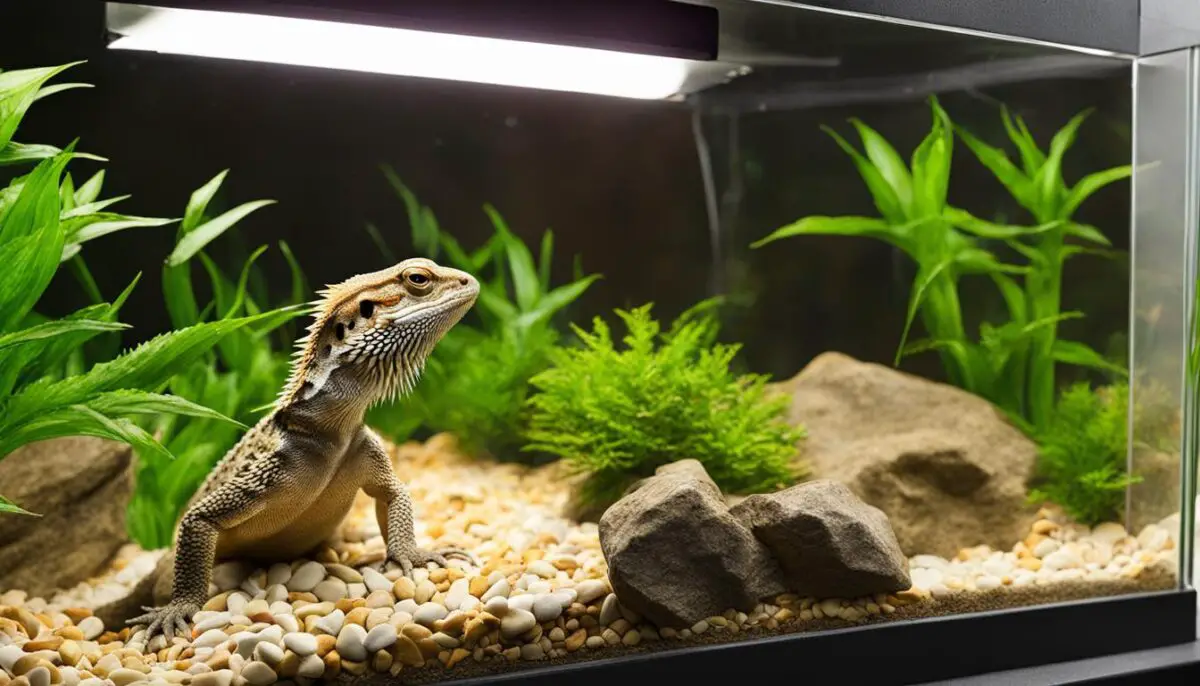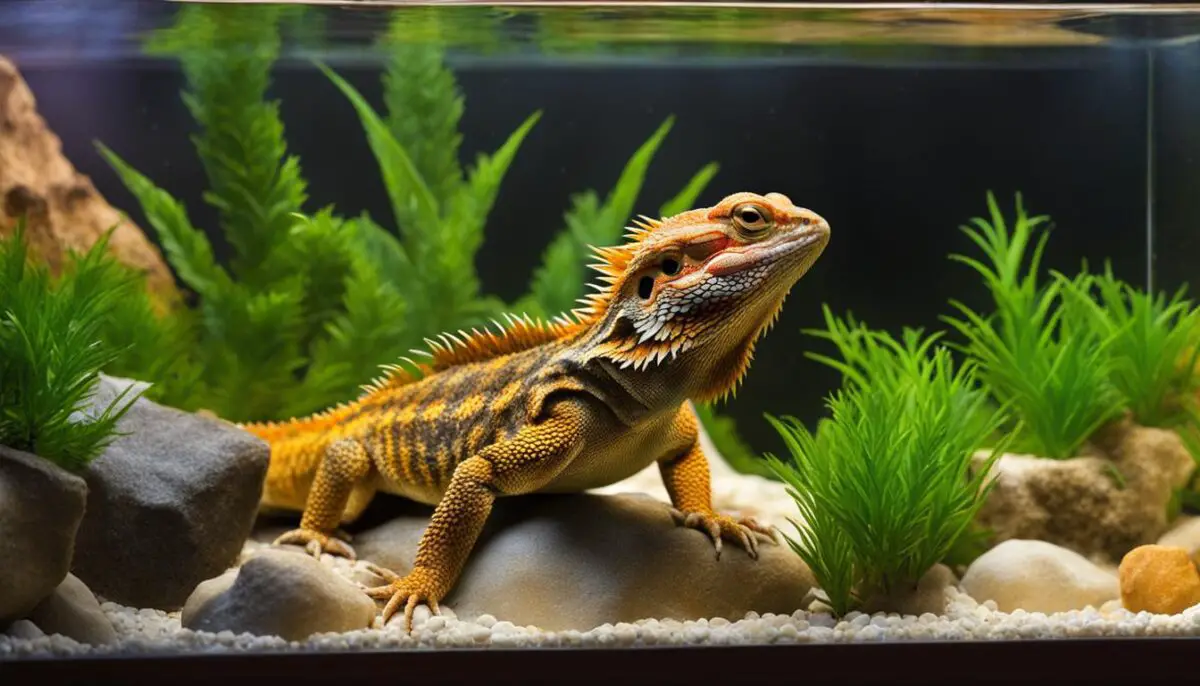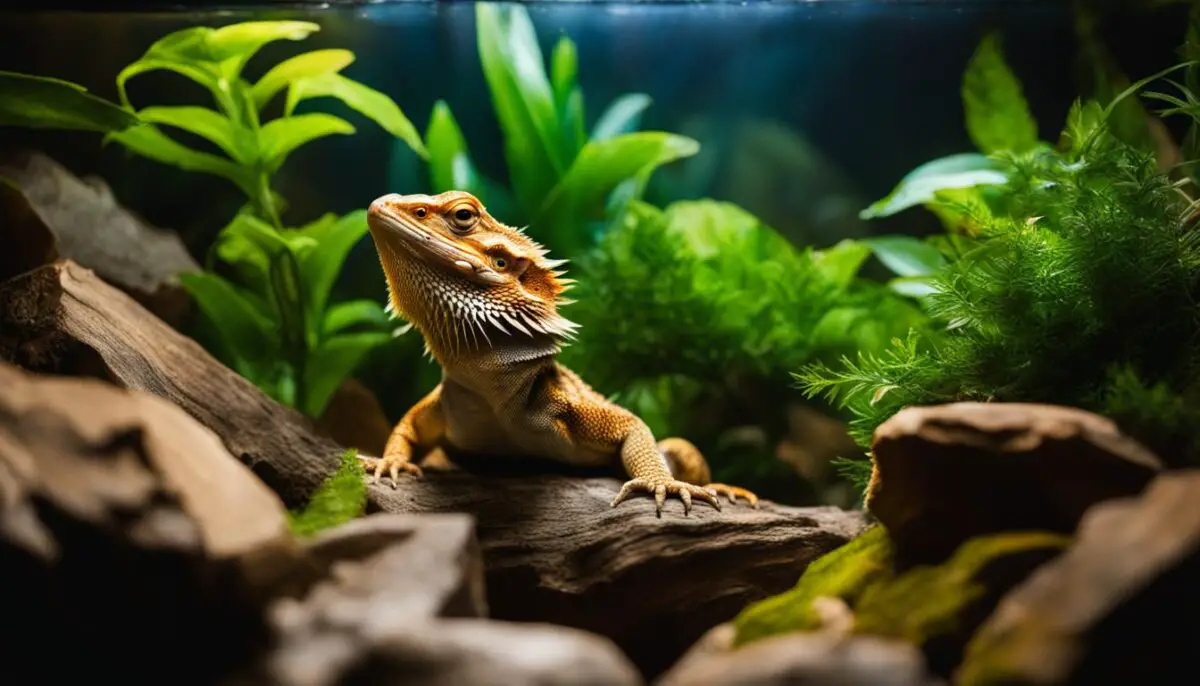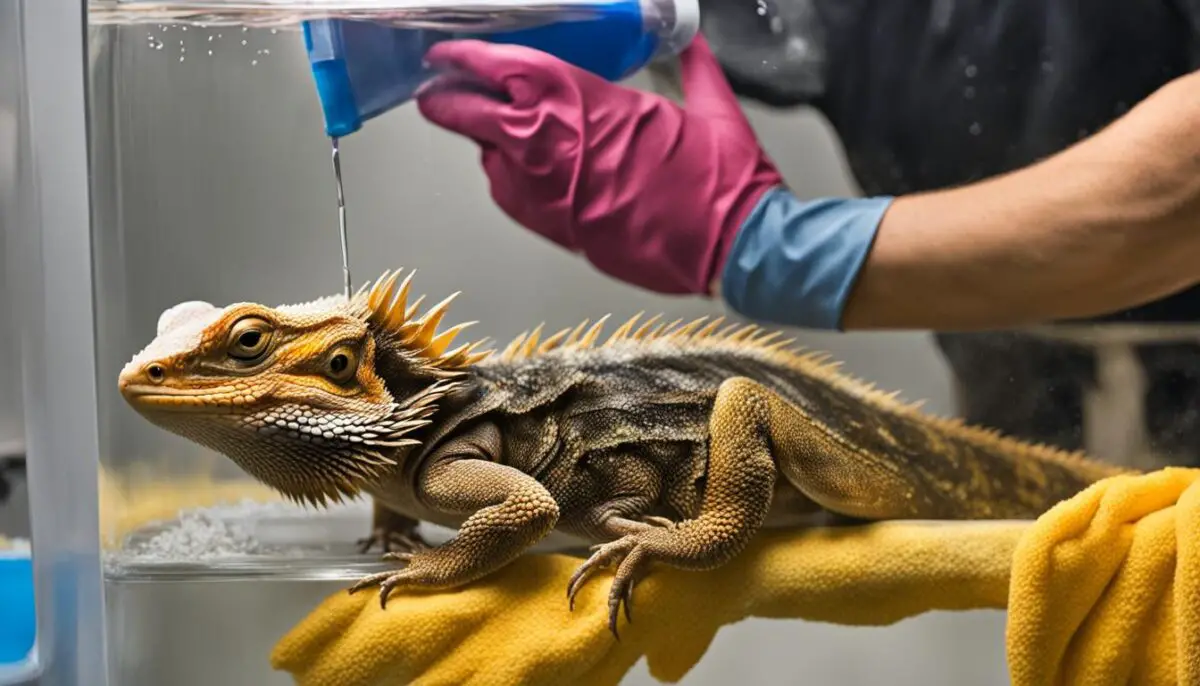When it comes to providing the ideal habitat for your bearded dragon, setting up the right tank is essential. In this article, we will guide you through the process of creating the perfect bearded dragon 125 gallon tank, from tank setup to habitat considerations. Whether you’re a new owner or looking to improve your current setup, this guide will help you create a comfortable and healthy environment for your scaly friend.
Key Takeaways:
- Choosing the right tank size is crucial for your bearded dragon’s comfort and well-being.
- Glass terrariums and PVC cages are popular enclosure options, each with their own advantages and disadvantages.
- Consider the location of the tank in your home, ensuring it is away from direct sunlight and free from loud noises.
- Gather all the necessary supplies, including a UVB light, heating element, thermometer, and hygrometer.
- When it comes to flooring, opt for non-particle substrates such as reptile carpet or ceramic tile for easy cleaning.
Bearded Dragon Tank Setup: Supplies
Before bringing your bearded dragon home, it’s important to gather all the necessary supplies for their tank setup. Providing the right equipment will ensure a comfortable and healthy environment for your pet. Here are the essential supplies you’ll need:
- Enclosure: Select a tank that is appropriate for the size of your bearded dragon. A 125-gallon tank is recommended for larger adults.
- UVB Light: Bearded dragons require UVB light for proper calcium absorption and vitamin D synthesis. Choose a high-quality UVB bulb specifically designed for reptiles.
- Heating Element: A heating element, such as a ceramic heat emitter or heat lamp, is necessary to maintain the appropriate temperature in the tank.
- Thermometer and Hygrometer: These tools will help you monitor and regulate the temperature and humidity levels in the tank.
- Basking Rock or Log: Provide a comfortable and sturdy surface for your bearded dragon to bask on.
- Flooring: Choose a suitable flooring option such as reptile carpet, paper towels, or non-adhesive linoleum.
- Shallow Dishes: Use shallow dishes for water and food to make it easier for your bearded dragon to access.
- Live Feeder Insects: Bearded dragons require a diet that includes live feeder insects. Research and provide appropriate options such as crickets, roaches, or mealworms.
Ensure that you have adequate space in your home to accommodate the tank and all the necessary equipment. Creating a comfortable and stimulating environment will contribute to the overall well-being of your bearded dragon.
Bearded Dragon Tank Setup: Supplies
| Supplies | Description |
|---|---|
| Enclosure | Select a tank that is appropriate for the size of your bearded dragon. A 125-gallon tank is recommended for larger adults. |
| UVB Light | Bearded dragons require UVB light for proper calcium absorption and vitamin D synthesis. Choose a high-quality UVB bulb specifically designed for reptiles. |
| Heating Element | A heating element, such as a ceramic heat emitter or heat lamp, is necessary to maintain the appropriate temperature in the tank. |
| Thermometer and Hygrometer | These tools will help you monitor and regulate the temperature and humidity levels in the tank. |
| Basking Rock or Log | Provide a comfortable and sturdy surface for your bearded dragon to bask on. |
| Flooring | Choose a suitable flooring option such as reptile carpet, paper towels, or non-adhesive linoleum. |
| Shallow Dishes | Use shallow dishes for water and food to make it easier for your bearded dragon to access. |
| Live Feeder Insects | Bearded dragons require a diet that includes live feeder insects. Research and provide appropriate options such as crickets, roaches, or mealworms. |
It’s important to gather all the necessary supplies before bringing your bearded dragon home. This will ensure that you are fully prepared to provide them with a comfortable and thriving habitat.
Bearded Dragon Tank Setup: The Enclosure
When it comes to setting up a bearded dragon tank, one of the most important considerations is the enclosure itself. The size, material, and location of the tank can greatly impact the comfort and well-being of your pet.
First and foremost, the size of the enclosure should be determined based on the size of your bearded dragon. For larger adults, such as those that require a 75-gallon or 125-gallon tank, it’s important to provide ample space for them to move around and explore.
In terms of material, glass terrariums and PVC cages are popular options. Glass terrariums offer excellent visibility, allowing you to observe your dragon easily. On the other hand, PVC cages provide better insulation, helping to maintain the ideal temperature and humidity levels within the tank.
Lastly, the location of the tank is crucial. It’s important to choose a spot in your home that is away from direct sunlight, as this can lead to overheating. Additionally, the tank should be placed in an area with enough space to accommodate its size, and away from loud noises that may stress out your pet.

| Enclosure Considerations | Recommended Options |
|---|---|
| Size | Based on the size of your dragon, consider a 75-gallon or 125-gallon tank |
| Material | Glass terrariums for visibility or PVC cages for insulation |
| Location | Away from direct sunlight and loud noises |
By selecting the right size, material, and location for your bearded dragon’s enclosure, you can create a safe and comfortable home for your beloved pet.
Bearded Dragon Tank Setup: Flooring
When it comes to the flooring of your bearded dragon’s tank, it’s essential to choose a substrate that promotes comfort and maintains their health. The right flooring option should be easy to clean, prevent impaction, and reduce the risk of bacterial and parasite growth. It’s important to avoid loose particle-based substrates as they can pose a danger to your dragon if ingested.
Instead, consider using non-particle substrates such as reptile carpet, paper towels, or non-adhesive linoleum. These options provide a solid and secure surface for your dragon to walk on, making it easier for them to move around without the risk of their claws getting stuck or injured. Another popular and safe choice is ceramic tile, which not only provides a solid surface but also helps to maintain proper humidity levels in the tank.
To ensure the flooring is suitable for your dragon, it’s important to consider their comfort and safety. Non-particle substrates are easy to clean and maintain, reducing the risk of bacterial growth and infection. They also prevent impaction, which can occur when loose particles are ingested and cause blockages in the digestive system. By choosing the right flooring, you can create a comfortable and safe environment for your bearded dragon.
| Substrate | Advantages | Disadvantages |
|---|---|---|
| Reptile carpet | – Easy to clean – Provides a secure surface – Prevents impaction |
– May need regular replacing |
| Paper towels | – Easy to replace – Provides a solid surface |
– Not aesthetically pleasing |
| Non-adhesive linoleum | – Easy to clean – Provides a solid surface |
– Requires proper installation |
| Ceramic tile | – Easy to clean – Helps maintain humidity levels – Provides a solid surface |
– May require additional heating |
Bearded Dragon Tank Setup: Landscaping and ‘Furniture’ Needs
Creating a vibrant and stimulating environment for your bearded dragon is essential for their overall well-being. Adding carefully selected decorations and ‘furniture’ to their tank can provide enrichment and create a more natural and engaging habitat. Here are some ideas to consider:
1. Basking Spot:
Include a large rock or branch in the tank for your bearded dragon to bask on. This will mimic their natural behavior in the wild and provide a comfortable and warm spot for them to relax.
2. Safe Plants:
Add some live or artificial plants to the tank to create a visually appealing and natural-looking environment. Make sure to choose plants that are safe for bearded dragons and non-toxic.
3. Hides and Caves:
Provide hiding spots in the tank where your bearded dragon can retreat to when they want privacy or feel the need to feel secure. These can be caves, branches, or specially designed hides.
4. Hammock or Ledge:
Consider adding a hammock or ledge where your bearded dragon can relax and bask off the ground. This can provide them with alternative basking options and create a more diverse and interesting environment.
Remember to regularly clean and sanitize any decorations you add to the tank to maintain a hygienic environment for your bearded dragon.
| Decorations | Benefits |
|---|---|
| Basking Rock or Branch | Provides a warm and comfortable spot for basking |
| Safe Plants | Adds a natural and visually appealing element to the tank |
| Hides and Caves | Offers privacy and security for your bearded dragon |
| Hammock or Ledge | Provides an elevated and relaxing area for your bearded dragon |
By carefully selecting and arranging decorations and ‘furniture’ in your bearded dragon’s tank, you can create a stimulating and visually appealing environment for them to thrive in.
Bearded Dragon Tank Setup: Temperature
Maintaining the ideal temperature in your bearded dragon’s tank is crucial for their health and well-being. They require a hot side and a warm side in their tank, with the hot side being around 100-110°F and the warm side around 80-90°F. This can be achieved with a combination of a basking light and a heating element, along with regular temperature monitoring using a thermostat and thermometer.

Creating a temperature gradient within the tank allows your bearded dragon to thermoregulate and choose the area that best suits their needs. The basking light should be positioned on the hot side of the tank, providing a direct source of heat for them to bask and regulate their body temperature. The heating element can be placed on the warm side, maintaining a consistent temperature throughout the tank.
It’s important to regularly monitor the temperature using a reliable thermostat and thermometer to ensure that it remains within the appropriate range. Fluctuations in temperature can negatively impact your bearded dragon’s health and metabolism. Adjustments may be necessary based on the size of the tank, the wattage of the heating equipment, and the ambient temperature of the room.
Bearded Dragon Tank Setup: Humidity
Maintaining the proper humidity level in your bearded dragon’s tank is essential for their health and well-being. Bearded dragons are desert animals and require low humidity levels in their tanks, typically around 30-40%. A hygrometer is a valuable tool for accurately monitoring the humidity levels in the tank.
To achieve the ideal humidity level, proper ventilation is crucial. Ensure that the tank has a screen lid or vents that allow for adequate airflow. This helps prevent moisture from accumulating and keeps the humidity level within the desired range.
Additionally, it is important to avoid substrates that retain moisture, as this can create a damp environment and lead to respiratory issues for your bearded dragon. Opt for non-particle substrates like reptile carpet, paper towels, or non-adhesive linoleum, which can help maintain a dry and clean habitat.
By monitoring the humidity levels in your bearded dragon’s tank and taking appropriate measures to maintain the proper humidity range, you will create a comfortable and healthy environment for your pet.
| Humidity Level | Recommended Actions |
|---|---|
| Below 30% | Add a shallow water dish to the tank and mist the enclosure lightly to increase humidity. |
| 30-40% | The ideal humidity range for bearded dragons. Monitor to ensure it remains within this range. |
| Above 40% | Improve ventilation by increasing airflow and reducing moisture sources in the tank. |
Remember, maintaining appropriate humidity levels is just as important as maintaining the correct temperature and lighting conditions in your bearded dragon’s tank. By providing the optimal environment, you are ensuring the well-being and happiness of your scaly companion.
Bearded Dragon Tank Setup: Lighting
Proper lighting is essential for the health and well-being of your bearded dragon. They require a full spectrum UVB light for proper calcium absorption and vitamin D synthesis. This helps prevent metabolic bone disease and ensures healthy growth. It’s important to choose a high-quality UVB light and position it correctly within the tank to provide adequate exposure.
When selecting a UVB light, opt for a linear fluorescent bulb or a compact fluorescent bulb specifically designed for reptiles. These bulbs emit UVB rays that closely mimic the sunlight bearded dragons would receive in their natural habitat. It’s recommended to have a UVB light that covers two-thirds of the tank, ensuring your dragon has access to enough UVB radiation.
Position the UVB light on top of a screen lid or mount it inside the tank, ensuring it is within the recommended distance from your dragon. The ideal distance varies depending on the strength of the bulb, so make sure to follow the manufacturer’s guidelines. Additionally, it’s important to regularly replace your UVB bulb every 6 to 12 months, as the UVB output diminishes over time.
Remember to establish a regular day-night light cycle within the tank to simulate your dragon’s natural habitat. This can be achieved by using a separate basking light and a low-wattage nighttime heat source. The basking light should provide a warm spot for your dragon to thermoregulate, while the nighttime heat source should emit minimal light to avoid disturbing their sleep.

Key Points: Bearded Dragon Tank Lighting
- Choose a high-quality UVB light designed for reptiles
- Position the UVB light correctly for optimal exposure
- Ensure the UVB light covers two-thirds of the tank
- Replace the UVB bulb every 6 to 12 months
- Establish a regular day-night light cycle in the tank
Table: Comparison of UVB Bulb Types
| Bulb Type | UVB Output | Recommended Distance |
|---|---|---|
| Linear Fluorescent | Moderate | 6 to 12 inches |
| Compact Fluorescent | High | 4 to 8 inches |
Bearded Dragon Tank Setup: Cleaning and Maintenance
Maintaining a clean and well-maintained tank is essential for the health and hygiene of your bearded dragon. Regular cleaning and maintenance tasks should be included in your care routine to ensure a clean and healthy environment.
Cleaning: Spot cleaning is an important task that should be done daily. Remove any waste, uneaten food, or shed skin from the tank using a reptile-safe disinfectant and a clean cloth. It’s important to clean the tank thoroughly every few weeks to prevent the buildup of bacteria or parasites. This includes removing all decorations, disinfecting them, and thoroughly cleaning the tank itself.
Maintenance: In addition to cleaning, there are other maintenance tasks that should be regularly performed. This includes replacing the substrate regularly, as it can become soiled and harbor bacteria. Regularly check and maintain temperature and humidity levels using a thermostat and hygrometer. Ensure that the UVB light is replaced every 6-12 months, as it loses its effectiveness over time.
By incorporating regular cleaning and maintenance tasks into your bearded dragon tank care routine, you can provide a clean and healthy environment for your pet, promoting their overall well-being and longevity.

| Task | Frequency |
|---|---|
| Spot cleaning | Daily |
| Thorough tank cleaning | Every few weeks |
| Replacing substrate | Regularly, as needed |
| Checking temperature and humidity levels | Regularly, using a thermostat and hygrometer |
| Replacing UVB light | Every 6-12 months |
Bearded Dragon Tank Setup: Additional Considerations
When setting up a bearded dragon tank, there are a few additional considerations to keep in mind. One important point to note is that bearded dragons should not be housed together. They are territorial creatures and can potentially harm each other if kept in the same tank. It’s essential to provide each bearded dragon with its own separate enclosure to ensure their safety and well-being.
Another factor to be aware of is brumation. Brumation is a natural process that is similar to hibernation. During this time, bearded dragons may experience a decrease in activity levels and appetite. It’s crucial to be prepared for brumation and provide proper care during this period. Make sure to monitor your dragon’s behavior and consult a veterinarian if you have any concerns.
Remember, the goal is to create a comfortable and healthy environment for your bearded dragon. By considering these additional factors and addressing them in your tank setup, you can ensure that your dragon thrives in its new home.
“Bearded dragons should not be housed together as they are territorial and can potentially harm each other.”
| Additional Considerations | Actions |
|---|---|
| Bearded dragon tank cohabitation | Avoid housing bearded dragons together to prevent territorial disputes and potential harm. Provide each dragon with its own enclosure. |
| Bearded dragon tank brumation | Be prepared for brumation, a period of decreased activity and appetite. Monitor your dragon’s behavior and consult a veterinarian if needed. |
Conclusion
Creating a proper bearded dragon tank is essential for ensuring the health and well-being of your pet. By considering factors such as tank size, material, location, flooring, temperature, lighting, and maintenance, you can provide the perfect habitat for your bearded dragon. This article has served as a comprehensive guide to help you set up an ideal bearded dragon tank.
Remember that the size of the tank should be appropriate for the size of your dragon, with larger tanks like the 75-gallon or 125-gallon tanks being recommended for larger adult dragons. You can choose from materials like glass terrariums or PVC cages, each with its own advantages and disadvantages.
Proper temperature and lighting are crucial for your bearded dragon’s health. Maintaining the right temperature gradient in the tank and providing a full spectrum UVB light are essential. Regular cleaning and maintenance, as well as being aware of additional considerations such as brumation and avoiding cohabitation, will contribute to a healthy and happy bearded dragon.
With this guide, you now have the knowledge and understanding to create an optimal bearded dragon tank setup. By providing a suitable environment, you can ensure the longevity and well-being of your bearded dragon companion for years to come.
FAQ
What size tank should I get for my bearded dragon?
For adult bearded dragons, a 75-gallon tank is recommended, but larger adults may require a 125-gallon tank.
What are the advantages and disadvantages of glass terrariums and PVC cages?
Glass terrariums provide visibility but may not offer as good insulation as PVC cages, which are better at retaining heat.
Where should I place the bearded dragon tank in my home?
Choose a location away from direct sunlight, with enough space for the tank, and free from loud noises.
What should I use for the flooring of the tank?
Avoid loose particle-based substrates and opt for non-particle substrates such as reptile carpet, paper towels, or non-adhesive linoleum. Ceramic tile is also a safe option.
What kind of “furniture” can I add to my bearded dragon’s tank?
You can add a large rock or branch for basking, safe plants for decoration, hides for them to hide in, and even a hammock for lounging.
How should I maintain the temperature in the tank?
Bearded dragons require a hot side around 100-110°F and a warm side around 80-90°F. This can be achieved with a basking light and a heating element.
What is the ideal humidity level for a bearded dragon’s tank?
Bearded dragons require low humidity levels of around 30-40%. Proper ventilation and avoiding substrates that retain moisture will help maintain the humidity.
What kind of lighting does a bearded dragon need?
Bearded dragons require a full spectrum UVB light for proper calcium absorption and vitamin D synthesis. Position the light correctly within the tank to ensure proper exposure.
How should I clean and maintain the tank?
Spot clean waste, replace substrates regularly, disinfect decorations, and regularly check and maintain temperature and humidity levels.
Can bearded dragons be housed together?
No, bearded dragons should not be housed together as they are territorial and can potentially harm each other.
What should I know about bearded dragon brumation?
Bearded dragons may go through a period of brumation, similar to hibernation, during which their activity levels and appetite may decrease. Be prepared and provide proper care during this time.


